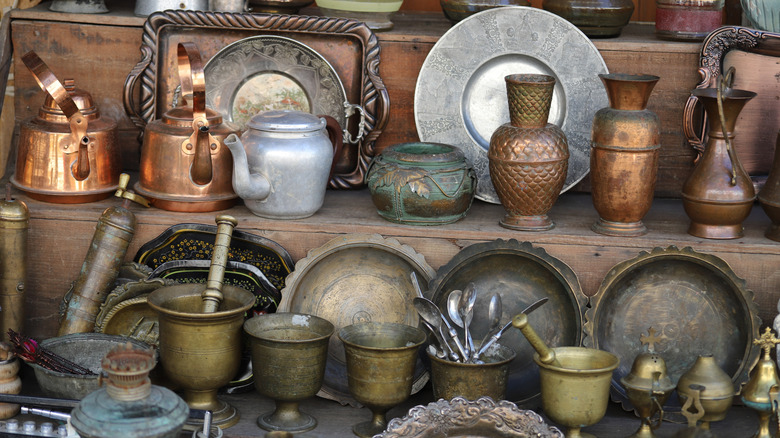Can A Magnet Really Help You Determine If Something Is Real Brass?
Thrifting can be great for your budget and the environment, but buying secondhand can make it difficult to know exactly what materials you are buying, especially when looking at some of the most valuable thrift items. For example, it can be hard to tell whether the candlestick or lamp you love at the store is real brass or another metal that is brass-plated. Online, a hack has circulated that suggests bringing a magnet. According to this hack, a magnet will stick to pieces plated or coated in brass but not real brass. Unfortunately for the thrifters out there, this hack is not completely true.
Since brass is not magnetic, there should be no magnetic pull when you hold a magnet to pure brass. If the magnet is attracted, then the piece is definitely not pure brass. Some other magnetic material underneath the brass plating is attracting the magnet. However, this hack is not perfect because of the possibility that there's another nonmagnetic metal underneath a brass coat, such as aluminum or copper. If this is the case, the magnet will not be attracted to the item even if it is not pure brass. So, a magnet can help you quickly rule out some brass-plated pieces, but it will not help you if there are nonmagnetic materials inside the brass plating. There are some tests, such as a visual test, scratch test, nitric acid test, and more, that can help you determine if an item is real brass. Unfortunately, many of the true tests for brass will cause at least some damage to the piece.
The best ways to determine if an item is real brass
If you really want to know more about your brass pieces, you will need to perform more comprehensive tests. A visual inspection, weight test, scratch test, and acid test will give you far more information than the magnet trick. Carefully clean your brass item and look it over. Brass is shiny and ranges from bright yellow to a warm reddish gold in color. You might even find a maker's mark or other label that can help you determine the piece's composition. As brass is a dense material, weight can also help you figure out if a piece is pure brass. Even small solid brass items should be fairly heavy.
Scratch tests and nitric acid tests will damage the item a bit but are very reliable tests. In a hidden area, you can lightly scratch the surface with a sharp object. A shiny yellow scratch suggests solid bronze, while silver and other colors suggest that the piece is brass-plated. For the acid test, you can drop nitric acid onto an inconspicuous spot. It will turn green on a brass surface, and other metals beneath the brass will change the color.
While the viral magnet test is not as foolproof as some people claim, it can immediately rule out some pieces that are not completely composed of brass. Whether you're trying to determine if your copper hardware is real or fake or looking for fixtures of solid brass, make sure you perform the proper tests.

